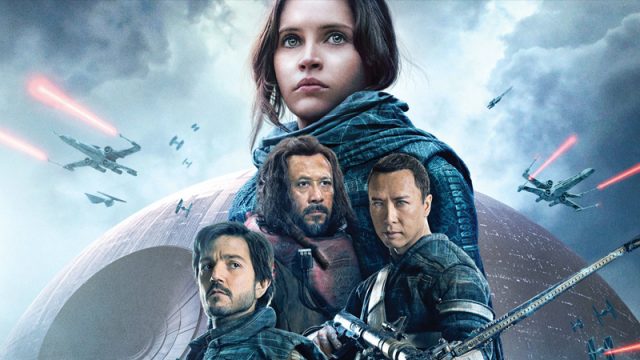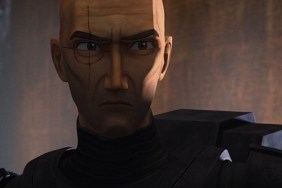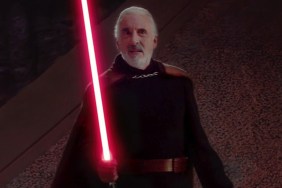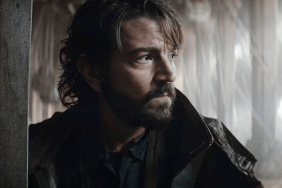Five years ago, Rogue One: A Star Wars Story hit cinemas like a bullet train. The public at large was still buzzing about J.J. Abrams’ The Force Awakens from the year prior and was eager to see what Kathleen Kennedy would do with George Lucas’ galaxy far, far away now that she essentially had an endless supply of resources and a book full of blank checks.
Despite costly — and well documented — reshoots, Rogue One, as directed by Gareth Edwards (Godzilla) and, to a lesser extent, Tony Gilroy (who more or less supervised the reshoots), amassed stellar reviews, with an 84% critical score and 86% audience score on Rotten Tomatoes, and earned a cool $1.056 billion from the worldwide box office against a massive $220 million budget. The pic remains the third highest-grossing Star Wars film behind The Force Awakens and The Last Jedi domestically, when not accounting for inflation.
Rogue One is a near-perfect example of a successful spin-off. Sure, the characters are a little flat, certain story beats feel a little forced, and the heavy-handed homages/callbacks to previous Star Wars entries induce the occasional eye roll. But the film’s flaws are overshadowed by its many strengths and a crowd-pleasing, action-packed, and emotional third act that successfully delivers everything fans want from the franchise.
Naturally, given the current state of Star Wars today, at least on the big screen, the only thought I had after a recent rewatch of Rogue One was, “Stop overcomplicating this franchise.” Star Wars films shouldn’t be hard. After all the movies, TV shows, and video games, audiences have a very clear idea of what they want and don’t want in a Star Wars film — lightsabers, space battles, dashing heroes, cunning villains, and simplistic stories of good versus evil.
The Force Awakens mostly understood this, which is why fans and audiences went nuts for the pic despite its shameless “remixing” of A New Hope. In the end, it was an exciting experience filled with interesting new characters, stellar special effects, and a huge dose of good ole fashioned fun.
By contrast, Rian Johnson’s The Last Jedi, despite its lofty ambitions, interesting ideas, and fascinating character arcs, tinkers too much with the Star Wars formula. Suddenly, we have far too many shades of gray, insignificant villains, and an infusion of not-so-subtle politics. As a standalone film, The Last Jedi works as a meta-commentary on the very nature of Star Wars and the cyclical pattern that frames the never-ending battle between good versus evil — all fascinating, heady ideas that have no place in the eighth entry of a franchise whose characters are more or less defined by the color of their laser swords.
Rogue One understands this better than most Star Wars entries and offers a very straightforward story with clearly defined heroes and villains who battle over a rather simplistic objective: the Death Star plans. Edwards, working from a script by Chris Weitz and Gilroy, certainly attempts to infuse the plot with a little more intrigue by positing Cassian Andor (Diego Luna) as a no-nonsense rebel pilot/intelligence officer whose emphatic allegiance to the Rebel Alliance results in the occasional tough decision, such as when he murders an informant early in the film and nearly executes Galen Erso (Mads Mikkelsen) despite his better judgment.
For the most part, though, Rogue One plays like a relatively straightforward Star Wars story. Its heroes, namely Jyn Erso (Felicity Jones), K-2SO (Alan Tudyk), Chirrut Îmwe (Donnie Yen), Baze Malbus (Wen Jiang), and Bodhi Rook (Riz Ahmed) are thinly drawn characters who possess one defining trait that makes them stand out from the rest, while villains such as Orson Krennic (Ben Mendelsohn) and Governor Tarkin (Guy Henry, hidden beneath layers of CGI) twirl their mustaches, bark orders and deliver grandiose speeches in a manner that would make Hitler blush.
Perhaps the only truly dimensional character in the bunch is Saw Gerrera (Forest Whitaker), an extremist performing his own shady acts to bring down the Empire — although his impact is lessoned by Whitaker’s strange performance, and whatever the hell Bor Gullet is.
Anyways, check out the opening scene to Rogue One, which sees Orson execute an innocent woman in the name of the Galactic Emperor. If it’s not already clear, the good guy is the sympathetic dude who just wants to live in peace on his farm. The bad guy is the man brandishing a cape and flanked by emotionless soldiers adorned in militaristic black outfits.
See that? Simple. Good versus evil. Now, audiences can sit back and watch the good guys blow up s— like the Death Star without concerning themselves over the absurd death toll or whether or not the massive, moon-like base contained innocent civilians and/or individuals who ultimately didn’t want to work for the Emperor.
By contrast, once we learn that there are actually Stormtroopers like Finn (John Boyega) who are kidnapped and forced into working for the New Order, scenes like the Battle of Takodana are a little more difficult to appreciate because you’re constantly wondering whether or not the bad guys are really all that bad.
Now, I’m not saying you can’t have nuance in Star Wars, but to do that you essentially have to rebuild the brand from the ground up. The Mandalorian is essentially doing this by introducing darker, edgier characters and ideas into its weekly episodes; one might argue that The Clone Wars and Star Wars Rebels accomplished this feat several years prior.
All that to say, Rogue One does its job and does its job well. Gareth Edwards and Co delivered a spectacular Star Wars film that gives audiences everything they expect from the long-running franchise. No, the pic doesn’t move the needle in any particular direction, but, as, technically, the fourth film in a series, it’s doesn’t need to. And so we get a huge helping of well-staged action …
… and perhaps one of the coolest battles in all of Star Wars via The Battle of Scarif …
… layered with one of the best Darth Vader moments ever …
… all of which add up to an exciting cinematic experience every Star Wars fan can enjoy.
Again, I’m not saying Star Wars can’t be novel. The franchise should indeed strive to be the best cinema has to offer, but not at the expense of its thematic roots. No, we don’t necessarily need constant homages and fan wanking in our films (as the failure of Solo: A Star Wars Story will attest), but we don’t need our expectations crushed to oblivion either.
Five years later, Rogue One stands as an example of how to do this kind of thing right. It may not be a great film, but it’s certainly a great Star Wars story.










